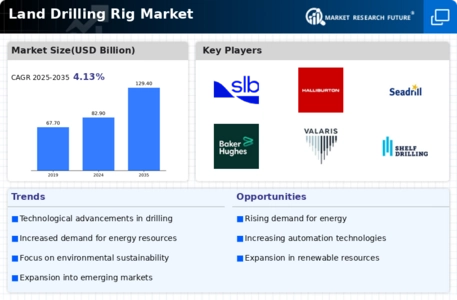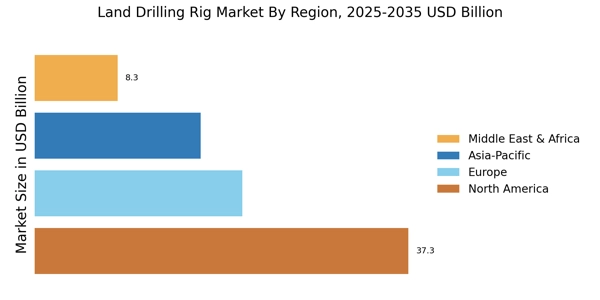The Land Drilling Rig Market is currently characterized by a dynamic competitive landscape, driven by technological advancements, increasing energy demands, and a growing emphasis on operational efficiency. Major players such as Schlumberger (US), Halliburton (US), and Baker Hughes (US) are at the forefront, each adopting distinct strategies to enhance their market positioning. Schlumberger (US) focuses on digital transformation and automation, aiming to optimize drilling operations through advanced data analytics. Halliburton (US), on the other hand, emphasizes strategic partnerships and mergers to expand its service offerings and geographical reach. Baker Hughes (US) is investing heavily in sustainable technologies, aligning its operations with global environmental standards, which appears to resonate well with current market expectations. Collectively, these strategies not only enhance individual company profiles but also intensify competition within the market, as firms strive to differentiate themselves through innovation and service excellence.
In terms of business tactics, companies are increasingly localizing manufacturing and optimizing supply chains to reduce costs and improve service delivery. The market structure is moderately fragmented, with several key players holding substantial market shares while numerous smaller firms contribute to the competitive dynamics. This fragmentation allows for a variety of operational strategies, enabling companies to cater to specific regional demands and preferences, thereby enhancing their competitive edge.
In August 2025, Schlumberger (US) announced a partnership with a leading technology firm to develop AI-driven drilling solutions aimed at improving efficiency and reducing operational costs. This strategic move is likely to position Schlumberger as a leader in the integration of artificial intelligence within drilling operations, potentially setting new industry standards for performance and reliability. The collaboration underscores the growing importance of technology in enhancing operational capabilities in the Land Drilling Rig Market.
In September 2025, Halliburton (US) completed the acquisition of a regional drilling services company, which is expected to bolster its market presence in emerging regions. This acquisition not only expands Halliburton's service portfolio but also enhances its ability to respond to local market needs, thereby strengthening its competitive position. Such strategic acquisitions are indicative of a broader trend where companies seek to consolidate their market presence through targeted investments.
In July 2025, Baker Hughes (US) launched a new line of eco-friendly drilling fluids designed to minimize environmental impact while maintaining operational efficiency. This initiative reflects Baker Hughes' commitment to sustainability and positions the company favorably among environmentally conscious clients. The introduction of such innovative products is likely to attract new customers and reinforce existing relationships, thereby enhancing market share.
As of October 2025, the Land Drilling Rig Market is witnessing significant trends towards digitalization, sustainability, and the integration of advanced technologies such as AI. Strategic alliances are increasingly shaping the competitive landscape, as companies recognize the value of collaboration in driving innovation and enhancing service offerings. Looking ahead, competitive differentiation is expected to evolve, with a pronounced shift from price-based competition to a focus on technological innovation, operational reliability, and sustainable practices. This transition suggests that companies that prioritize these aspects will likely emerge as leaders in the market.


















Leave a Comment